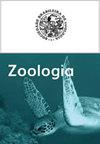巴西东南部大西洋森林Carlos Botelho州立公园的蝙蝠动物群(哺乳目:翼目目),包括圣保罗州的新分布记录
IF 1.8
4区 生物学
Q4 ZOOLOGY
引用次数: 6
摘要
卡洛斯博特略州立公园(PECB)是巴西东南部大西洋森林的一个大型遗迹,面积超过37,000公顷。由于该区的蝙蝠区系尚不清楚,我们在该区进行了首次蝙蝠调查,以提供该物种的分布、自然历史和分类数据。2016年10月至2017年9月,每月进行实地调查。使用地面雾网(39600平方米.h),冠层雾网(2017.5平方米.h)和搜索栖息地(42小时)进行捕获。共捕获毛条科、毛条科、毛条科34种蝙蝠412只。地面雾网共捕获11种,冠层雾网捕获5种,栖息地雾网捕获7种。Dermanura cinerea Gervais(1856年),Eptesicus taddeii Miranda, Bernardi & Passos(2006年),Glyphonycteris sylvestris Thomas(1896年)和Lampronycteris brachyotis (Dobson, 1879年)在圣保罗大西洋森林的调查中是罕见的,它们是用树冠雾网捕获的。1935年的schmidtorum Sanborn和1901年的Molossus currentium Thomas构成了本文章由计算机程序翻译,如有差异,请以英文原文为准。
The bat fauna (Mammalia: Chiroptera) of Carlos Botelho State Park, Atlantic Forest of Southeastern Brazil, including new distribution records for the state of São Paulo
Carlos Botelho State Park (PECB) is a large remnant of Atlantic Forest in Southeastern Brazil, with more than 37,000 ha. As its bat fauna is still unknown, we performed the first bat survey on PECB, to provide data on the distribution, natural history and taxonomy of the species. Fieldwork was conducted monthly, from October 2016 to September 2017. Captures were made using ground-level mist-nets (39600 m2.h), canopy mist-nets (2017.5 m2.h) and searches for roosts (42 hours).We captured 412 bats from 34 species of Phyllostomidae, Molossidae and Vespertilionidae. A total of 11 species were captured only in ground-level mist-nets, five in canopy mist-nets, and seven in roosts. Dermanura cinerea Gervais, 1856, Eptesicus taddeii Miranda, Bernardi & Passos, 2006, Glyphonycteris sylvestris Thomas, 1896 and Lampronycteris brachyotis (Dobson, 1879) are rare on surveys conducted in the Atlantic Forest of São Paulo and were captured in canopy mist-nets. Micronycteris schmidtorum Sanborn, 1935 and Molossus currentium Thomas, 1901 constitute the first record for the state of São Paulo, and were captured in canopy mist-nets and roosts, respectively. The species richness registered for PECB surpasses other surveys conducted in Atlantic Forest localities that use only ground-level mist-nets. Our results reinforce the importance of employing mixed capture methods, such as elevated mist-nets and searches for roosts.
求助全文
通过发布文献求助,成功后即可免费获取论文全文。
去求助
来源期刊

Zoologia
生物-动物学
自引率
0.00%
发文量
15
期刊介绍:
Zoologia, the scientific journal of the Sociedade Brasileira de Zoologia (SBZ), is an international peer-reviewed, open-access Zoological journal that publishes original research on systematics, evolution, taxonomy, nomenclature, biogeography, morphology, physiology, biology, ecology, symbiosis, conservation, behavior, genetics and allied fields. The journal, formerly known as Revista Brasileira de Zoologia, publishes original articles authored by both members and non-members of the Society. The manuscripts should be written exclusively in English.
 求助内容:
求助内容: 应助结果提醒方式:
应助结果提醒方式:


